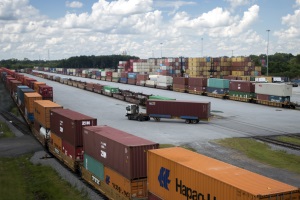Facility Development: Georgia, Oakland
![]() Print this Article | Send to Colleague
Print this Article | Send to Colleague
Georgia Ports Authority Approves Rail, Gate Capacity Expansion Projects

When complete, GPA's Mason Mega Rail Terminal will double rail lift capacity to 1 million containers per year,
reach new markets and reduce impact on the local community.
Photo/Stephen B. Morton, Georgia Ports Authority
The Georgia Ports Authority (GPA) has approved rail and gate expansion projects that will significantly increase capacity at Garden City Terminal in the Port of Savannah. The decision came as the agency’s marine terminals were experiencing record container volumes and double-digit cargo tonnage growth.
Specifically, the board approved expenditures of $42.27 million as part of GPA's $128 million Mason Mega Rail Terminal. The project will expand the Port of Savannah's on-dock rail capacity by 100 percent, supporting increased service to an arc of inland markets from Memphis to Chicago. A total of $90.7 million has been allocated to the project thus far. Construction is slated to begin next month and be completed by the end of 2020.
At that same November 13 meeting, the GPA board also approved a $13.2 million project to expand the existing Gate 8 at Garden City Terminal by adding pre-check lanes. The addition will help the GPA seamlessly absorb future growth and offer a better link to the Jimmy Deloach Parkway, which provides a direct truck route from the port to Interstate 95. The project will expand the terminal's gate infrastructure by 12.5 percent for a total of 54 truck lanes. By reducing truck congestion, it will also reduce the impact of truck traffic on the local community.
Port of Oakland's Deal for ex-Army Base gets first OK
Oakland Port Commissioners on November 9 gave initial approval to a 15-year agreement with CenterPoint Properties for a logistics center on the site of a former Army supply depot in the heart of the Port of Oakland. The tentative agreement caps nearly 15 years of planning and includes commitments to hire local workers.
The agreement comes up for final vote November 30. If Commissioners approve it for a second time, the deal becomes official in January.
The Base Realignment and Closure (BRAC) Commission closed the Oakland Army Base in 1993. The land was transferred to the City of Oakland and Port of Oakland from 2003-2006.
The agreement calls for CenterPoint Properties to develop a $52 million logistics facility on the port-owned property. Construction would culminate 20 months of negotiations between CenterPoint, the port, and Revive Oakland and Oakland Works, which are coalitions of more than 30 organizations including labor, community and faith partners.
The project would be the first phase of a planned Seaport Logistics Complex that could eventually encompass nearly 180 acres. The vision for the complex: modern distribution centers, including a railyard, close by Oakland’s Outer Harbor marine terminals. The port initiated development there last year with the opening of a $100 million railyard.
Work on CenterPoint’s 440,000-square-foot building could begin as early as the first quarter of 2018.
Central to the deal has been the Revive Oakland and Oakland Work Coalition’s collaboration with the Port of Oakland and CenterPoint to develop a jobs policy. The policy is envisioned as an economic driver and job generator. Among the stipulations:
- Preferences for hiring residents, particularly those in neighborhoods nearest the port.
- Special consideration for disadvantaged residents including the chronically unemployed, single parents, formerly incarcerated and military veterans.
- Funding for a local, community-based workforce development partner, the West Oakland Job Resource Center, to train work force candidates and provide the opportunity to refer job applicants.
Under terms of the agreement, CenterPoint Properties would construct and manage the first building at the complex. Tenants would likely include companies requiring transloading cargo between trucks, trains and vessels for shipment.
"We’ll provide the most efficient and most cost-effective means of delivering cargo," said Port Maritime Director John Driscoll. "That will be a major driver of our growth in the years ahead."

